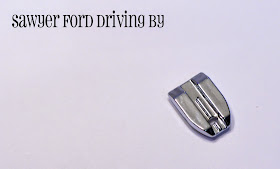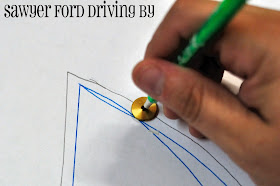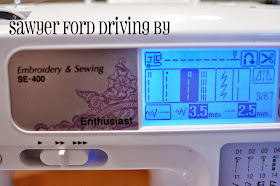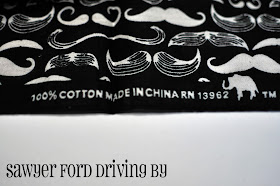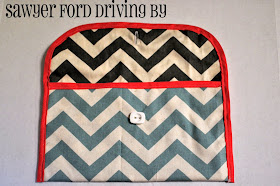▼
Thursday, May 29, 2014
Presser Foot Series: Invisible Zipper Foot
Today I'm going to tell you about the invisible zipper foot.
You wouldn't believe how easy this foot makes installing invisible zippers! On the bottom of the foot are these two groves that fit right over the teeth of the zipper, making sure your needle goes exactly where it needs to go.
First, read the instructions that came with your invisible zipper regarding how to place it against the edge of your fabric. If you're repurposing a zipper, as I did here, and don't have the instructions, the best way to do it is to lay your zipper down right side up, then place the sides of your fabric where it will be sewn, seam allowance already folded, on top of the zipper where it will meet the zipper. Pin one side in place, then open your zipper all the way up.
Now, if you are working on the right side of the zipper, place the teeth of the zipper under the right groove. If you're working on the left side of the zipper, you'll utilize the left groove. Make sure your needle is in the center position no matter which side of the foot you're using. The groove will position the zipper so that your seam goes right along the teeth.
Sew all the way down until you're stopped by the zipper pull, then stop and sew the other side of the zipper. Now, zip up the zipper. Okay, this is the part I forgot to get picture of, but it's really simple. You're just going to close up the rest of the seam on the skirt. Sew it with a seam allowance matching that of the zipper, and sew from the bottom of the skirt up, sewing the bottom of the zipper when you come to it.
See how it's sewn right into the seam!
Here's the finished skirt! It ended up being just a little loose on her, but that will give her a little more time to wear it.
See how invisible the zipper is!
Wednesday, May 28, 2014
Presser Foot Series: Overcasting Foot
Today we're talking about the overcasting foot.
I found this sweet embossed polyester-cotton blend in the remnant bin at Joann's and knew it was destined to be a skirt for Lily.
There was just about a half a yard there. I decided to make a modified version of Simple Simon and Co's Vintagely Modern Skirt. My main differences were making it less full (due to the fact that the fabric was only twice the width of her waistline instead of the three times width their pattern calls for), adding trim at the hemline, an invisible zipper in the back, and pockets.
I'm not going into detail on how I made the skirt, because you should really check out the link above. They explain it so much better than I ever could! To add the pockets I followed this tutorial over at Make It & Love It. But I did want to show you this handy little tool I used to add a seam allowance to the pocket pattern I drew. It's called a Quilter's Wonder Wheel, and I picked it up at Tuesday Morning ages ago for 99¢. Do you have a Tuesday Morning in your town? If you do, you should totally check out their sewing/crafting aisles. TONS of great deals! I recently found sewing machine needles there priced 3 five packs for 99¢. That's 15 needles for less than $1! Well, tax, but whatever.
Anyway, to use the wheel you just stick a pencil in the center and roll it around the edge of your pattern to add a perfect 1/4 inch seam allowance! Mechanical pencils work best because the hole it so small.
The overcasting foot came in handy here for finishing the seams of the skirt without using a serger. This particular stitch on my machine is one that I love because it seams and finishes at the same time, but you can use it with just about any finishing stitch, including a plain old zigzag.
The overcasting foot is designed with a guide for the edge of your fabric to make it easy to keep the seams even and to make sure that the overcasting stitches fall off the edge of the fabric as they're supposed to.
These stitches can generally be done with a standard zigzag foot, but I find that I get more consistent, neat finishing if I take just a second to switch to the overcasting foot.
Tomorrow we will talk about how to use the invisible zipper foot to install the zipper, and I'll show you the finished skirt, but here's a little peek at the pockets.
Tuesday, May 27, 2014
So today kind of got away from me...
It was my intention to have another post in the Presser Foot Series up today. But I'm trying to organize all my crafting supplies, I had a couple of errands to run, and I ended up spending two hours with my mom going through all her sewing stuff looking for a piping foot (no luck). By the time I got home it was time to deal with kids and a late dinner, so the Presser Foot Series will resume tomorrow. Coming up, we will be looking at:
- the overcasting foot
- the roller foot
- the invisible zipper foot
- the gathering foot
- the walking foot
- the straight stitch foot
- the open toe foot
- the free motion foot
Sunday, May 25, 2014
Presser Foot Series: Rolled Hem Foot
Today we're talking about the rolled hem foot.
A rolled hem foot is specially designed to help you achieve tiny neat hemlines on lightweight fabrics. As you can see, there is a little spiral guide on the foot.
This is to tuck your fabric edge into a neat fold just before it goes under the needle.
You will see this hem on things like napkins, bandanas, and formal dresses in satins or chiffons. This size of hem is very hard to achieve neatly with simple pressing because it is so small. And many of the fabrics it is appropriate on are not able to be ironed or pressed.
My girl Taylor came home with a few new maxi dresses from Nanny and Papaw a few days ago. They were all so cute on her, but all but one were way too long. Enter the rolled hem foot!
This dress was made from super stretchy knit, so I was a little nervous about how the rolled hem foot would handle it. Fabric like this can have a tendency to get sucked down into your machine with a standard zigzag foot. There was no need to worry though - it handled it wonderfully! Now if this were not a maxi dress you would probably want to go with something more stretch friendly like a three step zigzag or a double needle stitch. But because the hemline has such freedom of movement this was perfect.
I cut the dress off just 1/4 inch longer than I wanted the final length to be. Then I hemmed the raw edge of the piece I cut off to make sure the fabric would work with the foot. It turned out great, so I started on the dress.
It can be a little fiddly to get your seam started, especially on a closed hem like a dress, so I recommend starting near a side seam if possible. Slide the edge of your fabric up and into the spiral guide. It will help keep it feeding in neatly if you hold the edge folded a bit over the left side of the foot.
Your needle needs to be in the center position, and you want to start with a slow speed and remain there until you are comfortable going a bit faster. It's important to keep your seam folded up as it goes into the foot. Keep your hand on the fabric to keep it from shifting and pulling out of the guide.
Look how pretty that hem is!
Two important tips to remember: make sure that the edge you are hemming is a smooth one. Look it over before hemming and make sure you don't have any jagged spots. The edge you are hemming also needs to be a clean edge. Trim any frayed threads before hemming or they will end up getting rolled into your hem and sticking out from it.
I sewed a few other fabrics to show you how it behaves with them. I'm working on a skirt for Lily using these fun mustache bandanas. But the bottom of the bandanas had this lettering that I wanted to get rid of, so I cut it off and hemmed it. This fabric did particularly well with the rolled hem foot.
This is a strip of satin that shows what happens if you have an uneven or frayed edge.
This is a chiffon that did well, although the shimmery plastic dots fused to the fabric made parts of the hem a little wavy where the dots were part of the seam.
Tomorrow Tuesday we will be talking about the overcasting foot.
A rolled hem foot is specially designed to help you achieve tiny neat hemlines on lightweight fabrics. As you can see, there is a little spiral guide on the foot.
This is to tuck your fabric edge into a neat fold just before it goes under the needle.
You will see this hem on things like napkins, bandanas, and formal dresses in satins or chiffons. This size of hem is very hard to achieve neatly with simple pressing because it is so small. And many of the fabrics it is appropriate on are not able to be ironed or pressed.
My girl Taylor came home with a few new maxi dresses from Nanny and Papaw a few days ago. They were all so cute on her, but all but one were way too long. Enter the rolled hem foot!
This dress was made from super stretchy knit, so I was a little nervous about how the rolled hem foot would handle it. Fabric like this can have a tendency to get sucked down into your machine with a standard zigzag foot. There was no need to worry though - it handled it wonderfully! Now if this were not a maxi dress you would probably want to go with something more stretch friendly like a three step zigzag or a double needle stitch. But because the hemline has such freedom of movement this was perfect.
I cut the dress off just 1/4 inch longer than I wanted the final length to be. Then I hemmed the raw edge of the piece I cut off to make sure the fabric would work with the foot. It turned out great, so I started on the dress.
It can be a little fiddly to get your seam started, especially on a closed hem like a dress, so I recommend starting near a side seam if possible. Slide the edge of your fabric up and into the spiral guide. It will help keep it feeding in neatly if you hold the edge folded a bit over the left side of the foot.
Your needle needs to be in the center position, and you want to start with a slow speed and remain there until you are comfortable going a bit faster. It's important to keep your seam folded up as it goes into the foot. Keep your hand on the fabric to keep it from shifting and pulling out of the guide.
Two important tips to remember: make sure that the edge you are hemming is a smooth one. Look it over before hemming and make sure you don't have any jagged spots. The edge you are hemming also needs to be a clean edge. Trim any frayed threads before hemming or they will end up getting rolled into your hem and sticking out from it.
I sewed a few other fabrics to show you how it behaves with them. I'm working on a skirt for Lily using these fun mustache bandanas. But the bottom of the bandanas had this lettering that I wanted to get rid of, so I cut it off and hemmed it. This fabric did particularly well with the rolled hem foot.
This is a strip of satin that shows what happens if you have an uneven or frayed edge.
This foot did not come with my machine, but it is available at a very reasonable price. Mine came in this kit (not an affiliate link), which is less than $10 including shipping and includes 11 pieces.
Saturday, May 24, 2014
Presser Foot Series: Button Foot
Today we're going to learn how to use our machine to sew on a button. Admittedly, it's not very hard to sew a button on by hand. But it is kind of a pain in the butt. At least to me it is. So if I can use my machine to do it, I'm happy to do so.
So this is really easy. First grab your button foot, which looks like this:
Pop it on your machine and grab the button you're going to use. Now measure between the holes of your button. What you're looking for is the distance in millimeters.
Now follow your manual's instruction to change your stitch width. For this project I set my width to 4.5 mm, the largest my machine will accommodate. Now place your button under your presser foot, with the holes between the prongs of the foot. Now manually move your flywheel to lower the needle slowly to check and make sure it is landing in one of the holes in the button. When you have the button position correct, start sewing. Your machine should stop automatically when the button is sewn on.
When you are finished, pull the loose thread(s) through the holes in the button to the back and tie in a knot to keep it from unraveling.
And now we're all done! I found that my case, like Cheri's, will hold a slim wipes case and 3-4 size 3 diapers.
Tomorrow we will explore the rolled hem foot.
Friday, May 23, 2014
Presser Foot Series: Automatic Buttonhole Foot
This sewing foot looks nothing like most sewing feet. In fact, I was super intimidated by mine, and I never even tried it until I found a great video showing how to use it over at Simple Simon and Co. If you're more of a video person, check it out here (by the way, they're totally my sewing heroes!). They also have a video showing how to use a Bernina buttonhole foot. But if you're more of a written tutorial type of person, keep reading!
This little foot really does take all the work out of buttonholes for you. Whether you use a foot pedal or have a push button start/stop, the machine will sew the buttonhole and stop automatically when it's done.
First you want to choose your button. I decided to go with this vintage white rectangle one. Place it on your project where you want it to lie when it's inserted into the buttonhole. Use a disappearing fabric marker to mark the top and bottom of the button. If you're using a button with different sized sides like mine, make sure you're marking the buttonhole just a little taller than the short sides. Marking this is optional, but I find that it helps me in lining the fabric up with my buttonhole foot, especially since this buttonhole will lie perpendicular to the edge of my fabric.
Connect your dots, hopefully more neatly than me!
Insert your button and push the sliding sides together around it. This determines the length of your buttonhole, so make sure to insert your button as it will be inserted into the buttonhole.
Now snap your foot onto your machine.
Choose your stitch. My machine has several buttonhole options, but I went with the standard square one here.
Now on a Brother you will need to pull down the buttonhole lever, located at the left rear of the machine.
Now line your fabric up. The machine will sew the buttonhole from front to back, so the very end of the mark you made needs to be centered in the middle of the three red marks on your foot. Here I was making a practice buttonhole on a piece of scrap fabric, always a good idea!
Here's our finished (practice) buttonhole. Now to open it up, you will rip right up the center, between the stitches, with your seam ripper.
One excellent trick I learned from Simple Simon and Co. is to place a pin right at the top of your buttonhole so that you don't accidentally cut too far with your seam ripper.
Test to make sure your button fits.
When you've had enough practice, go ahead and sew the buttonhole on your project.
Looks great! Tomorrow we'll learn how to use your machine to sew on the button.



